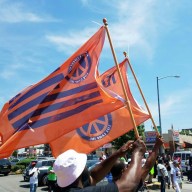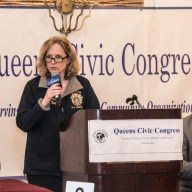By Gary Buiso
More than two months before local residents were up in arms over a cellular phone tower in Marine Park, Community Board 18 was contacted about its controversial arrival. But there was little, if anything the board could have done to stop the tower’s construction, according to its district manager, Dorothy Turano. “We really have no recourse whatsoever,” Turano said. In an Oct. 5 letter to the board, an environmental consulting firm briefly details the project, a required step in conforming to federal law. “The site consists of an existing two-story building located at 3524 Avenue S…[and] is proposed to be developed with communications antennae to be mounted to a proposed 18-foot-high monopole to be situated on the roof of the building,” the letter reads. Local residents like Bob Solowitz learned of the tower’s arrival on or around Dec. 17, when work began on the building’s rooftop. “This is just another failure of a section of government,” said Solowitz. “Government fails to be proactive for the people who they represent, and in effect, goes along with things,” he continued. Asked his reaction when he learned the board knew of the tower’s arrival, he said, “I cant give you a four letter word, can I?” Turano said she sent out notification to local civic groups about the letter the board received. “We send copies of whatever we get to community leaders,” she said. Turano continued, “Don’t you think we would fight it if we could? We do try—just not in a hysterical way.” The National Environmental Policy Act requires T-Mobile, the communications giant behind the cell tower, to conduct a survey to weigh the potential impact of the tower to “historical and archaeological resources” within the vicinity of the site. Turano said she sent out notification to the consulting firm that the tower should not be located at that site, as it is approximately 200 feet away from the historic Lott House. Russ Stromberg, T-Mobile’s senior manager of development, said its consultant never received any letter from the community board. “We received no feedback,” he said. T-Mobile’s consultant, Westchester-based G.C. Environmental, dispatched the letter. All cellular phone carriers are required to provide notification regarding their cell sites. Some do some in local newspapers, and others notify community boards. In New Springville in Staten Island, T-Mobile last summer withdrew an application to erect a tower following stiff opposition from the community and elected officials. The tower was relocated across the street from the original site. Asked what recourse Marine Park residents might have, Stromberg said: “If the community supports a site that meets our engineering needs and the landlord is amenable….then we will absolutely consider it.” But, he continued, in an urban environment like New York City, moving just two blocks can have a “dramatic impact” from an engineering perspective. The Staten Island case might be unique, he said. “We were fortunate in that case to find a readily alternative in the immediate proximity.” Stromberg has told this newspaper that the tower is well suited for Marine Park and that residents will eventual “get used to” its presence. T-Mobile maintains that the tower is safe, but local residents are still not convinced that their health won’t be jeopardized by the tower’s presence. Despite rumors that the building’s landlord was looking to break the already-signed contract to host the cell tower, Stromberg said that all parties involved are fully supportive of the arrangement.




























